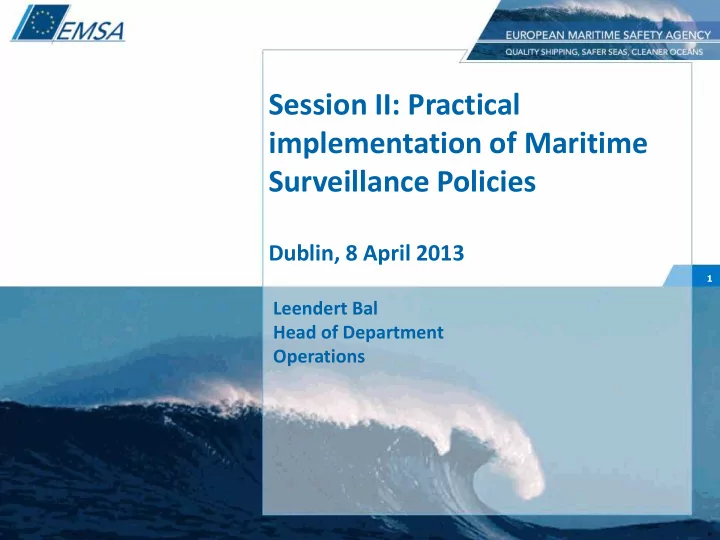

Session II: Practical implementation of Maritime Surveillance Policies Dublin, 8 April 2013 1 Leendert Bal Head of Department Operations
Regulatory Agency of the European Union • 10 years in existence • Own legal identity • Technical and operational support • ~240 staff, 24 nationalities • ~80 staff in Operations Department • Annual overall budget: ~55 million Euros • HQ Lisbon, Portugal
Updated EMSA mandate: Reg.100/2013/EC, published on 15 January 2013 “The Agency should provide operational assistance to the Member States and the Commission. This should include services such as the Union Maritime Information and Exchange System ( SafeSeaNet ), the European satellite Oil Monitoring Service ( CleanSeaNet ), the European Union Long Range Identification 3 and Tracking Data Centre ( EU LRIT Data Centre ) and the EU Port State Control inspection data base ( Thetis ).”
New element under “Core tasks” - facilitate cooperation between the Member States and the Commission: By providing, …, relevant vessel positioning and earth observation data to the competent national authorities and relevant EU bodies … in order to facilitate measures 4 against threats of piracy and of intentional unlawful acts …
5
IMDatE – the Conceptual View 2.Service Configuration: • Data Streams (AIS, LRIT..) 1. Capabilities: • Data fusion • Community-specific data • Dissemination (S2S) • Custom visualisation • Automated monitoring • Automated Monitoring • Addition of custom data Framework • New analysis tools – for • Alerting means • Dissemination format 6 combined data • Satellite AIS 3. Rationalisation among 6 applications: • Single Sign-On • Common user management • Common databases
Integrated Data Information Nautical Chart Shore based AIS Integrated ship’s track LRIT Satellite AIS Direct access to PSC information Direct access to PSC information ship’s risk status Ship Risk Profile: High Risk Inspection Priority: 1 (mandatory) Eligible to be banned: No Eligible for Expanded Insp.: Yes Navigation Status Direct access to voyage details Extended search capabilities
Single and multi-source vessel position reports LRIT only S-AIS only 8 AIS only AIS+S-AIS+LRIT
AIS and S-AIS reports with track interpolation Interpolation considers: • Previous position reports • Heading and speed • Correctness thresholds S-AIS AIS 9 9/
Route prediction using ship call information Route prediction using ship call information Destination port: Destination port: Rotterdam Rotterdam Alert!! Vessel off track Predicted route Predicted route Actual route Actual route Position Report Position Report Voyages Voyages Predicted Route Predicted Route Events / Incidents Events / Incidents
Correlation between satellite detected vessels and ship position reports 11 A graphical interface may provide “time slider” visualization for replaying data. 11/
Initial Monitoring Algorithms - V essel entering or leaving Area - At sea encounter – 2 vessels - Drastic change in ETA - Vessel - Off track considering reported voyage - Under/over reporting - Sudden change of speed - Sudden change of heading - Sudden change of port of destination - Check if vessel is anchored.
Roll-out of tailor-made IMDatE services: • EU Agencies and bodies • EU NAVFOR • EFCA • Blue Belt (MOVE/TAXUD for customs as of 2014) • Volunteering EU Member States 13 • France, • Italy, • Netherlands, • Portugal, • Spain, • United Kingdom. 13/
Example of Graphical Interface customisation 14
15
16 www.emsa.europa.eu
IMDatE: Out-of-the-box features (1 of 2) • Validation - against complete EMSA Data Processing: vessel registry -operational databases • Live picture of last known vessel positions • From multi-source data (AIS, LRIT, S- • Correlation: AIS etc) • Automated correlation of VDS from • Multi-criteria vessel search SAR images with position reports. • Enrichment of position reports with • Ship track creation data from multiple databases • Track association • Track interpolation and prediction • Display of satellite images (SAR and • History of vessel voyage optical) and overlay of ship tracks. • Position reporting correctness checks - • Handling of ‘incident’ information – Kalman filter processing inspections/sightings/events. • Easy addition of new data – e.g. • Handling of reported voyage surrounding AIS positions received by information – next port of call, last port patrol vessels, on-scene incident reports 17/ etc. etc
IMDatE: Out-of-the-box features (2 of 2) Supporting Tools: • Aggregation - Single request to have Automated behaviour monitoring and ALL available information on a vessel alerts: from different EMSA applications • Monitoring engine • Area Centric Query • Comprehensive and expandable set • All available information in a of automated monitoring functions. given area – ship tracks, • E.g vessel entered/exited a incidents, satellite images, non- defined area correlated VDS…. • Detection of at-sea-encounter • Graphical interface with tailored between two vessels. symbols, filtering of data, user • Vessel deviated from expected specific data. and reported route. • Overlay of community specific data • Vessel not reporting or under- using WMS/WFS web services reporting. • Choose between receiving emails, System-to-System interfaces: PDF reports, XML messages. • Position dissemination facility 18/ • New XML interfaces
Recommend
More recommend